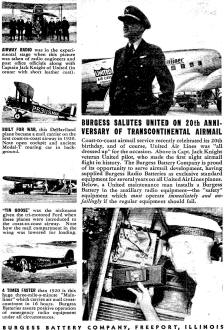|
January 1941 QST
 Table of Contents Table of Contents
Wax nostalgic about and learn from the history of early electronics. See articles
from
QST, published December 1915 - present (visit ARRL
for info). All copyrights hereby acknowledged.
|
Before there were electric generators
onboard airplanes to power communications equipment, aviators relied on storage
batteries to operate their radios. Before that, there were no radios at all aboard
airplanes. Although Wilbur and Orville Wright first piloted their
Wright Flyer in 1903, by
the end of the decade airplanes were becoming a common sight across the country
and across the civilized world. By the middle of the second decade experiments were
being done with airborne radio. They were heavy vacuum tube units with heavy lead-acid
batteries. Antennas sometimes hundreds of feet long needed to be reeled
out and in once at altitude. The earliest transmitter (for 2-way communications)
were spark gap types, meaning of course Morse code was the medium. That's right,
the pilot - often alone without an assistant - sent messages by tapping out dits
and dahs using a straight key strapped to his thigh. Moving into the 1920s, radio
telephony had become standard equipment aboard transport and military aircraft.
Much of it early-on was battery powered. This 1941 issue of the ARRL's QST
magazine contains an advertisement by the Burgess Battery Company celebrating the
20th anniversary of transcontinental airmail service, along with touting their role
in accommodating the business by supplying batteries for airborne radios. Most of
the earliest airmail pilots flew with no radio - even on routes over the Rocky Mountains.
If you are interested in vintage airplanes, you might want to read about the
ride Melanie and took in the
Ford Tri-Motor airliner that visited Erie airport back in 2013.
Burgess Battery Company Advertisement
 Burgess Salutes United on 20th Anniversary
of Transcontinental Airmail Burgess Salutes United on 20th Anniversary
of Transcontinental Airmail
Coast-to-coast airmail service recently celebrated its 20th birthday, and of
course, United Air Lines was "all dressed up" for the occasion. Above is Capt. Jack
Knight veteran United pilot, who made the first night airmail flight in history.
The Burgess Battery Company is proud of its opportunity to serve airmail development,
having supplied Burgess Radio Batteries as exclusive standard equipment for several
years on all United Air Lines planes. Below, a United maintenance man installs a
Burgess Battery in the auxiliary radio equipment - the "safety" equipment which
must operate immediately and unfailingly if the regular equipment should fail.
Airway Radio was in the experimental stage when this picture was taken of radio
engineers and post office officials along with Captain Jack Knight of United (in
center with short leather coat).
Built for War, this DeHaviland plane became a mail carrier on the first coast-to-coast
airway in 1920. Note open cockpit and ancient Model-T touring car in background.
"Tin Goose" was the nickname given the tri-motored Ford when these planes were
introduced to the coast-to-coast airway. Note how the mail compartment in the wing
was lowered for loading.
4 Times Faster than 1920 is this huge three-mile-a-minute "Main-liner" which
carries air mail cross-continent in 16 hours. Burgess Batteries assure positive
operation of emergency radio equipment under all circumstances.
Burgess Battery Company, Freeport, Illinois
Posted July 6, 2020
|









